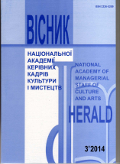АТАРАКСІЯ ЯК ГАРМОНІЙНА ВКОРІНЕНІСТЬ БУТТЯ ДУХУ В ПОВСЯКДЕННОСТІ
Ataraxia as harmonious rootedness the existence of the spirit in everyday life
Author(s): Viktoria RudkoSubject(s): Anthropology, Ethics / Practical Philosophy, Social Philosophy
Published by: Національна академія керівних кадрів культури і мистецтв
Keywords: anthroposophy; ataraxia; harmony; eurythmy; existence;
Summary/Abstract: The relevance of research of ataraxia as achieved harmony with the world and ourselves is to improve understanding of the implementation of individual subjective form of human experiences about the surrounding objective reality in the aesthetic sphere of social life.At the beginning of XX century, after World War I, when people came to despair of the absurdities and horrors of the outside world, seemingly strong order collapsed and all the values that are usually considered inviolable got questionable, and the integrity of world order was destroyed, and people had around them nothing solid on which they could rely, and harmony with the world disappeared, there was only returning to their own internal, so that here find the unconditional support that was not belonging to the objective world order, and therefore was out of influence by the elements of total collapse .According to existentialists, a man first exists and then becomes its own merits. In other words, existence precedes essence of life and people do not always realize or want to realize own essence. Therefore, in the existential-philosophical understanding of man there are two opposite and sharply separated from each other states: the reliability and unreliability of individual human existence. These two modes represent two real ways in which a man exists.In terms of existential philosophy ingenuine life is not harmonious. In the theory of existentialism there are several ways that a person can use to overcome the unreliability of human existence, that is to find harmony in the life. But they did not create a complex method of exit beyond the existence, did not produce universal method of obtaining individual subjective harmony and finding harmony with the world. Existentiality as a philosophical setting does not specify ways and means to achieve happiness and harmony. Therefore, the focus of existence gets the nature of transcendence, which is faith, hope, love, which play an important role in the formation of subjective harmony and the harmony of man and the world .In existential philosophy the harmony is interpreted as a measure of life. Because of the polarity of spirit and matter appears their opposition. This is due to the fact that there no third component of the triangle that gives stability. In this case, the third component is a measure, that it gives stability to the unity of "spirit, matter and measure". Therefore, if a person is harmonious, it has an internal ordering. You also need to take into account the timeliness. So ataraxia as a state of harmony, proportion and eurhythmy of subject and object relations becomes the highest value.In the nineteenth century the loss of a single ideological concept together with social, environmental, moral and ethical crisis led to the desire to find new spiritual guide, rethinking of the central philosophical problems. From this perspective, aesthetic, artistic and practical activities by philosopher Rudolf Steiner, who founded spiritual science of "anthroposophy", was a response to the challenge of time, an attempt to solve the problems of the era. The greatest attention of researchers attracted characteristic for Steiner’s philosophy integrity, associated primarily with understanding of human fossil inclusion in the overall global process, the role of each individual in shaping the future of human culture.The most important Steiner's contribution to the field of artistic activity was the creation of a new art form – eurhythmy – the art of special harmonic motion. Important in eurhythmic movement is that the dance is not born spontaneously, not arbitrarily from the fantasy or experiences of the artist, but appears as the embodiment of the laws that rule the world movement. In eurhythmy an attempt to find a connection with the universal human content is implemented.Steiner’s anthroposophy is not a dogmatic religious doctrine, but nor an abstract theory. It focused on the lively knowledge that enables the human soul with direct experience of truth. The main conclusion of Steiner's epistemology is the claim that thinking is the essence of the world and the individual human mind is another form of this essence. So the leading idea of Steiner’s pedagogy is the idea of a free self-governing schools, that is not serving to the state, and even not to society as a whole, but focused solely on the individual's needs and requests. In the focus of this way stated problem there must be questioned about freedom and moral rights. Based on Steiner's philosophy, which is characterized by integrity, associated with understanding of human fossil inclusion in the overall global process, the role of each individual in shaping the future of human culture, we conclude that a man is like a piece of macroworld should maintain harmony with the environment, the harmony of "truth, virtue and beauty". As the highest purpose of human activity Steiner considers transformation of reality into a work of art.So Steiner's anthroposophy, as the analysis of the literature shows, is not an isolated phenomenon in the history of philosophy, but a link of the European idealist tradition, based on the philosophy of Stoicism and maintains its aesthetic values, such as ataraxia state of harmony, proportion and eurhythmy with the world. Sources 9.
Journal: Вісник Національної академії керівних кадрів культури і мистецтв
- Issue Year: 2014
- Issue No: 3
- Page Range: 8-12
- Page Count: 5
- Language: Ukrainian

